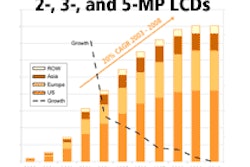Doctors often overlook osteoporosis and its associated risks in women who present with fractures, according to two recent studies. The first looked at bone mineral density (BMD) thresholds for pharmacologic intervention to prevent fractures. The second evaluated the management of osteoporosis in fracture patients.
Using data from the National Osteoporosis Risk Assessment, a multi-institutional group examined treatment thresholds one year after a bone densitometry exam (DEXA). The investigators were led by Dr. Ethel Siris from the Toni Stabile Osteoporosis Center at Columbia-Presbyterian Medical Center in New York City. Siris' co-authors are from institutions in California, Colorado, Maryland, and Pennsylvania.
The study included 149,542 Caucasian, postmenopausal women, ranging in age from 50-104. Baseline BMD was measured by peripheral bone DEXA at the heel, finger, or forearm. The patients were followed for the next 12 months.
The results showed that a total of 2,340 new osteoporotic fractures were reported by 2,259 women during that time period. "Fracture rates were highest in women with the lowest T scores," the group stated. "More than 80% of women who reported having a fracture within 12 months had peripheral T scores higher than -2.5, and two-thirds had T scores exceeding -2.0" (Obstetrical & Gynecological Survey, November 2004, Vol. 59:11, pp. 769-771).
The authors noted that treating only women with a T score of -2.5 or less would not significantly reduce fractures. Instead, physicians should pay closer attention to women with moderate loss of bone mass who are still at an increased fracture risk. In this study, even the women who had a lower T score still sustained 45% of the osteoporotic fractures and 56% of the hip fractures.
When these patients do go to the emergency room with fractures, they should be checked for osteoporosis, according to the second study presented at the 2004 American Osteopathic Association (AOA) meeting in San Francisco.
George Stamataros and co-authors from the University of Medicine and Dentistry of New Jersey in Newark looked at whether postmenopausal women, who were hospitalized for hip or vertebral fractures, had received pre-event treatment for osteoporosis. Also, they sought to determine if these women were discharged with a diagnosis of osteoporosis, as well as treatment recommendations.
"The significance of treating osteoporosis following a fracture becomes evident when considering that a previous fracture predicts a second one -- women who have suffered a postmenopausal fracture are more likely to have a subsequent fracture," the group wrote in a poster presentation.
For this retrospective review, data was collected from three New Jersey hospitals, resulting in records for 100 women (ages 55-89) who had been admitted for hip or vertebral fractures.
Their records were reviewed for the following osteoporosis-related information:
- Admission diagnosis
- Risk factors, such as age, weight, tobacco use, and estrogen deficiency
- Discharge diagnosis
- Treatment recommendations
Of the 100 women, 32 were admitted with an osteoporosis diagnosis and 68 were not. Of the 32 women, 47% were still discharged without a documented osteoporosis diagnosis, the authors found. Among the 68 women who were not checked for the disease, 89.7% still did not receive an official diagnosis at discharge.
The group also found that 77/100 patients had nine or more risk factors for osteoporosis. Of the 61 women who were not diagnosed either upon admission or at discharge, 72% had three or more risk factors.
For treatment, 33 women were prescribed some form of osteoporosis treatment, including calcium and vitamin D supplements and/or medications.
"Overall, these findings suggest there is an insufficient management of osteoporosis in postmenopausal women who have been hospitalized for a hip or vertebral fracture," the group concluded, despite the existence of National Osteoporosis Foundation guidelines recommending that these women, should they present with fractures, undergo a DEXA scan. The study results have inspired the authors to devise an in-house treatment plan at their institution.
Although experiments have been done with micro-CT and MRI for bone density testing, DEXA is still the gold standard. For screening purposes, women under 65 should undergo central DEXA (hip and spine). For women over 65, heel DEXA is preferred. Baseline screening should be done at the onset of menopause (AOA's Women and Wellness, September 2004, Vol. 1:2, pp. 10-14).
By Shalmali Pal
AuntMinnie.com staff writer
December 27, 2004
Related Reading
Rads urged to standardize reporting of vertebral fractures, November 23, 2004
Strontium ranelate reduces vertebral fracture risk in postmenopausal women, October 21, 2004
Half of older adults at risk for osteoporosis, U.S. report finds, October 15, 2004
Bone DEXA interpretation only as great as the sum of its parts, October 31, 2003
Copyright © 2004 AuntMinnie.com



















